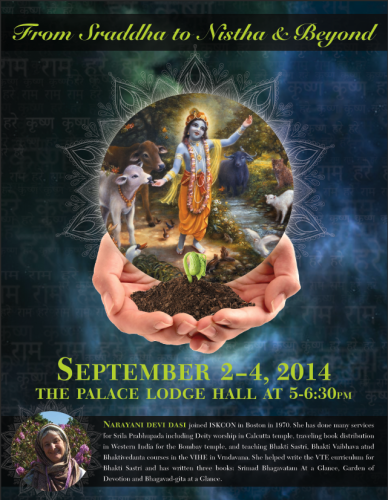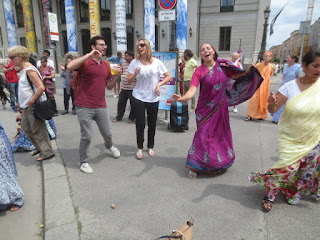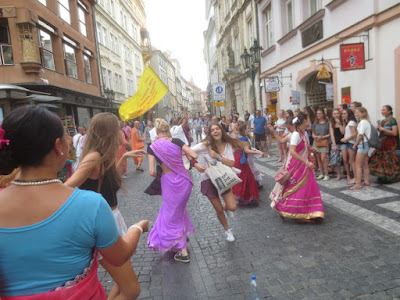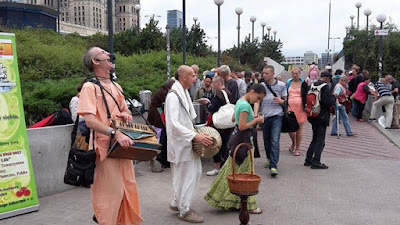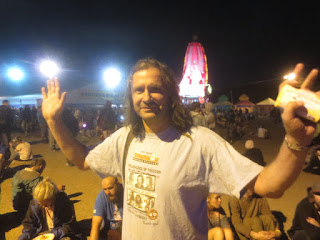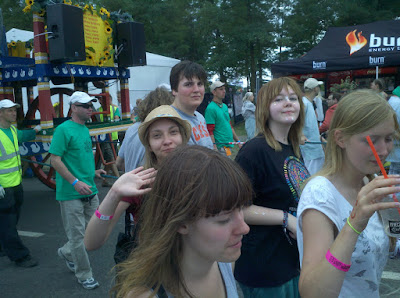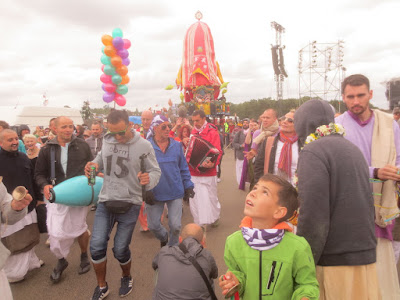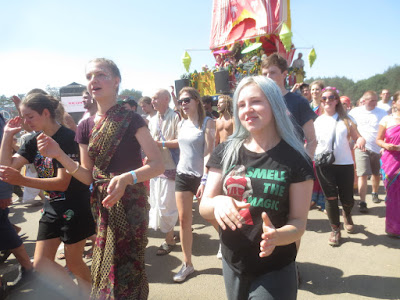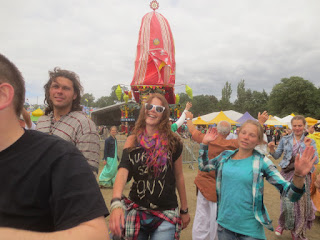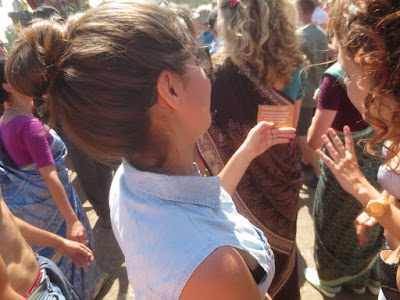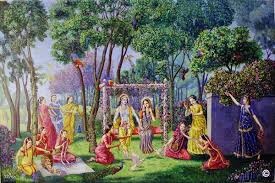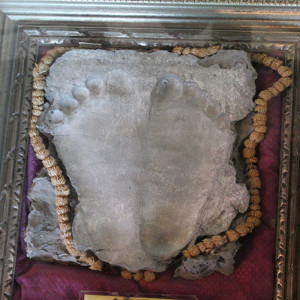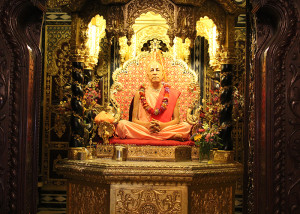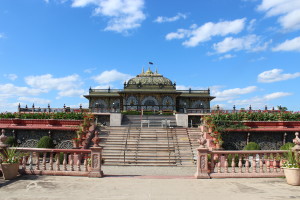Monday, August 24th, 2015
Sunday, August 23rd, 2015
→ The Walking Monk
Saturday, August 22nd, 2015
→ The Walking Monk
Friday, August 21st, 2015
→ The Walking Monk
Hare Krishna! The Art of Krishna Conscious Parenting
The goal of…
→ Dandavats.com

Hare Krishna! The Art of Krishna Conscious Parenting
The goal of our educational system is to inspire our children to become devotees of Krsna, while living in this world like perfect, responsible ladies and gentlemen. We see such example in the life of Radhika Raman Prabhu, who, along with his younger brother, was homeschooled by his mother, Aruddha Mataji. Their story is a success story and thus we invited them to share it with us. Their seminar was inspiring and gave us a sense of recommitting ourselves to the standards established by Srila Prabhupada. The home environment, saturated with spiritual practices, while minimizing other distractions, is so essential and beneficial for attaining our desired goal. They urged us to forgo the excessive use of electronics and instead, invest our time studying the Srimad Bhagavatam with our children
Read the entire article here: http://www.dandavats.com/?p=19339
Auspicious Beginning
→ TKG Academy
In the Vedic tradition, life’s important passages are marked through a ceremony called samskara. It is meant to create an auspicious beginning and a positive impression. One such ceremony, the Vidyarambha Samskara, marks the children’s entrance to a school and the beginning of their formal education, usually around the age of 5.
On the Wednesday preceding the first day of school, our new Kindergarten students gathered in the temple room and, under the auspices of Nityananda Prabhu, participated in the ceremony. We began by chanting the Hare Krsna Maha Mantra, with the students taking turns leading the kirtan. Nityananda Prabhu offered arati to Srila Prabhupada, and then led the group in prayers to invoke the blessings of Adi-Sarasvati, the consort of the Lord and original goddess of learning. Finally, a brahmana (twice-initiated) devotee guided each of the four new kindergartners in writing “ABC” and “Hare Krsna” on small chalkboards. The dust from this writing was used to put tilak on the forehead of each student, and finally all were treated to maha sweets.
We congratulate and welcome the Kindergartners and all of our students and pray that we may please Lord Krsna and His devotees with our studies and all of our endeavors.
The “Secret Weapon” revealed! (8 min…
→ Dandavats.com

The “Secret Weapon” revealed! (8 min video)
Indradyumna Swami: One time Srila Prabhupada described prasadam as Lord Caitanya’s ‘secret weapon.’ When properly cooked with love and devotion, prasadam has an amazing ability to purify the heart and awaken love for Krsna. On our festival tour in Poland this summer we focused on preparing first-class foodstuffs for our guests who purchased them from our restaurant each evening. By the middle of the tour the prasadam was in such demand we had to double up our efforts!
Watch it here: https://goo.gl/lofchS
Teachers as Students
→ TKG Academy
I find it refreshing and enlivening to be sitting behind the “bench” of a student. “Good students make good teachers”, they say. Teachers are usually in the position of giving, of instructing, but they, too, are continuously learning, growing, developing.
This summer TKG Academy staff had the good fortune of participating in professional development organized by ISKCON’s Ministry of Education in Houston, TX. We had the honor of attending classes by teachers such as Prana Prabhu, a very experienced educator and curriculum developer, Subhra Mataji, the principal of Goswami Academy, and others. We reviewed concepts such as Inquiry Learning, The Reflective Teacher, Assessment, Storytelling in the Classroom, Teaching in Multilevel Classroom, Early Childhood Growth and Development, Vedic Math, Restorative Practices and more.
The training was followed by an Educational Conference, attended by ISKCON educators from North America. We specifically connected with other K-12 teachers and administrators, exchanged ideas with them and paved the path for future collaboration. Resources were shared and the beginning of ISKCON NA Gurukula objectives were laid out. We felt inspired by their association and look forward to continuing to serve along with them.
Finally, during the official “in service” days, we also had the pleasure of exploring the AVID program (Advancement Via Individual Determination) and its essential components, under the tutelage of Mani Manjari, a former TKG Academy teacher. She walked us – hands-on – through the process of collaborative learning and left us all enthused to enter our respective classrooms and put model into practice.
Harinama in Moscow (Album with photos)
Srila Prabhupada: A pure…
→ Dandavats.com

Harinama in Moscow (Album with photos)
Srila Prabhupada: A pure devotee cannot forget the Supreme Lord for a moment, and similarly the Supreme Lord cannot forget His pure devotee for a moment. This is the great blessing of the Krishna conscious process of chanting the maha-mantra. (Bhagavad-gita 9.14 Purport)
See them here: https://goo.gl/592XYp
Seminar Starting September 2nd by Narayani DD
→ New Vrindaban

New Vrindaban Brijabasi Spirit 2015-08-26 12:22:49
→ New Vrindaban Brijabasi Spirit
Hare Krishna! ISKCON50 Launch at ISKCON-London
On Thursday 13th…
→ Dandavats.com

Hare Krishna! ISKCON50 Launch at ISKCON-London
On Thursday 13th August, ISKCON-London officially launched their year-and-a-half long celebrations across 2015 and 2016 to commemorate the 50th Anniversary of ISKCON by holding a festival to mark 50 years since Srila Prabhupada departed from India to the US aboard the Jaladuta. The festival started with an Adivasa Ceremony led by Head Pujari, HG Murli Manohara dasa, and included themed classes from senior Srila Prabhupada disciples, HH Janananda Gosvami and HG Adi Karta dasa. Attendees also experienced an ecstatic maha-harinama and in the evening, there was a full Temple Room with devotees singing Yadi Prabhupada Na Hoite – a bhajan composed by HH Jayapataka Swami. No festival is complete without a sumptuous prasadam feast also being served. Attendees were treated to a special Vyasasana display showing Srila Prabhupada boarding the Jaladuta.
Read the entire article here: http://www.dandavats.com/?p=19331
Bhakti Sangam Festival in Ukraine begun! (Album with…
→ Dandavats.com

Bhakti Sangam Festival in Ukraine begun! (Album with photos)
Indradyumna Swami: Myself and Bada Haridas prabhu arrived in Shatsk, Ukraine just in time to attend the first evening kirtan with several thousand devotees at the Bhakti Sangam Festival. Over 6,000 devotees are eventually expected for the 7-day event. Havi prabhu, a senior Prabhupada disciple, led an amazing kirtan that had all the devotees chanting and dancing in great happiness.
See them here: https://goo.gl/Li5cmq
Adventures to reach Ukraine
→ SivaramaSwami.com
The post Adventures to reach Ukraine appeared first on SivaramaSwami.com.
Hare Krishna! Everything for Krishna and nothing for me
After…
→ Dandavats.com

Hare Krishna! Everything for Krishna and nothing for me
After hearing so many complaints from so many devotees, Srila Prabhupada called a meeting of all the devotees. Practically all the devotees in the temple came into Srila Prabhupada’s room, and he listened very sympathetically to what every devotee had to say, and he was really concerned and wanted to improve things. At one stage the GBC for India protested: “Srila Prabhupada, my only intention was to execute Your Divine Grace’s will.” And Prabhupada replied a little sarcastically, “Is it My Divine Grace’s will that the devotees should be disturbed?” And he made a system. He named certain leaders—Tamal Krishna, Yamuna, me—and said that they should get together every week and discuss the problems, and whatever they decided they should write down in a minute book, and they should all sign and then do what they agreed.
Read the entire article here: http://www.dandavats.com/?p=19328
**Janmashtami Special Edition** NBS#19: Birth Of The Unborn
On…
→ Dandavats.com

**Janmashtami Special Edition** NBS#19: Birth Of The Unborn
On the auspicious occasion of Sri Krishna Janmashtami and the appearance day of Srila Prabhupada, we wish to humbly offer this special edition at Their lotus feet.
Read the entire article here: http://www.dandavats.com/?p=19325
Madireksana pictures of the Nama-hatta
→ SivaramaSwami.com
The post Madireksana pictures of the Nama-hatta appeared first on SivaramaSwami.com.
New Jersey Church-Turned-Temple to Get Three Day Grand…
→ Dandavats.com

New Jersey Church-Turned-Temple to Get Three Day Grand Opening
ISKCON of Central New Jersey will celebrate the grand opening of its new 18,000 square foot temple in Plainfield – a converted church – with a three-day weekend festival from August 28th to 30th. Close to 10,000 people, including devotees, members of the Indian community, and other locals are expected to attend at the height of the festivities. Plainfeld Mayor Adrian Mapp has confirmed his attendance, while ISKCON has also invited local pastors, rabbis and mullahs in attempt to develop good interfaith relationships.
Read the entire article here: http://goo.gl/TCmTfl
The latest issue of Sri Krishna-kathamrita Bindu e-magazine
KK…
→ Dandavats.com

The latest issue of Sri Krishna-kathamrita Bindu e-magazine
KK Bindu #357: Topics include, “A Wheel for Krishna” a picture poem by Keshava Kashmiri, and more …
Read the entire article here: http://www.dandavats.com/?p=19322
Lord Balarama: Part 2
→ KKSBlog
(Kadamba Kanana Swami, 10 August 2014, Czech, Balarama Jayanti, Srimad Bhagavatam 10.1.8)
Balarama and Krsna are the same but there are differences also. The principle difference is that Balarama is the Supreme Lord in the mood of serving Krsna, ekale īśvara kṛṣṇa, āra saba bhṛtya yāre yaiche nācāya, se taiche karenṛtya (Caitanya Caritamrta Adi 5.142), there is one Supreme Lord Krsna and all others are serving him, including expansions of the Lord, including Lord Balarama. So Krsna is known as sevya bhagavan and Balarama is known as sevak Bhagavan, or Krsna is the Lord who is being served and Balarama is the Lord who is serving. Balarama serves Krsna in many possible ways.
He expands himself as Ananta who has many, many mouths and with all these mouths, he glorifies Krsna. It is said that if you want glorify Krsna, you have to pray to Ananta because it is said that the mouth of Ananta is the jewel-case of the jewel of glorification of Krsna so in this way, Balarama is always serving Krsna by glorifying him. Adi-guru, Balarama is the original spiritual master. One must always glorify Krsna continuously.
Balarama also becomes the bed of the Lord, like Ananta Sesa, he becomes the seat of the Lord and all the utensils of the Lord – his shoes, his plate, his cup, musical instruments are all Balarama. Balarama even becomes Vrindavan for the pleasure of Krsna. Balarama provides all the pleasure for Krsna’s eternal pastimes.
When it comes to the material world, it is Balarama who expands himself into Maha Vishnu, Kṣīrodakaśāyī Vishnu and Garbhodakasayi Vishnu. In all respects, Balarama is serving Krsna – he is behind everything, behind the spiritual world and behind the material world.
Srimad Bhagavatam Class 07 01 34 by HG Bhakta Rupa Prabhu at ISKCON Juhu on 11 May 2015
→ Gouranga TV - The Hare Krishna video collection
Srimad Bhagavatam Class 07 01 34 by HG Bhakta Rupa Prabhu at ISKCON Juhu on 11 May 2015
Safe Interviews w/ Zack and Porcell. No Need to Be Suspicious.
→ The Enquirer
I had a week or two before Ray would show up in San Diego, so I mostly holed-up in my room upstairs and put together the fourth issue of Enquirer. The main features were interviews with Zack and Porcell. I see these as the first noticeable examples of what would become a rather nasty habit for me as the zine’s editor: bending words to obscure points I didn’t like and favor points I did like.
For example, I report Zack as saying: “I think leading a spiritual life means casting away and putting aside the physical nature in life, and the intellectual nature in life. But actually it’s using all three of them… And spirituality… like…”
What kind of editing is that?
Knowing Zack, and having the benefit of hearing his voice directly, it was pretty obvious to me what he wanted to say: that spiritual life isn’t something you have to throw away your material life for; that the two can and should be integrated, complimentary, and mutually nourishing. If I was actually editing to make the point Zack wanted to make, I would have written it like this: “I don’t think ‘leading a spiritual life’ means you have to cast aside the physical and intellectual aspects life. I think it means combining all three aspects of life: physical, intellectual, and spiritual.”
But I didn’t like that point, so I intentionally made it very vague and confusing. I didn’t like it because it seemed to go against my agenda for “dedicating myself completely” to Krishna consciousness.
The really strange part, though, is that Zack’s message of integrating the spiritual and material aspects of life is exactly the same message Krishna himself delivers in the third and fifth chapters of Bhagavad Gītā. I didn’t know that at the time, though. At the time, my knowledge of Krishna consciousness did not mainly come from direct statements in Sanskrit scripture, it mainly came from the way that the (mostly) western young men of ISKCON comprehended and practiced those statements. They definitely did think we should throw away everything – physical, intellectual, and otherwise – to join the temple and “devote ourselves completely to Krishna,” and they certainly weren’t shy about letting me know that I should do the same, asap. Why would I suspect that the devotees of the Krishna consciousness movement might not perfectly understand Krishna’s advice? Why would I suspect that they might see me almost as much as a resource as a “spirit-soul,” and that their very practical personal and institutional ambitions might seriously color their comprehension of Krishna’s actual advice?
In any case, coming back to the zine, I didn’t always rely on unethical editing. More often I took a softer tact and simply steered the interviews clear of controversy and straight into subjects I knew we had no disagreements about. For Zack this involved the role of spirituality as a vehicle for non-violent social change, and the shitiness of the modern television-culture society that pressures the youth to conform to their hollow norms. It was basically the same topic for Porcell. Yes, we spoke briefly about how happy he was that Ray found something he can really get into (Krishna), but mostly we focused on how useless modern materialistic society is.
Editorially, this is a lot like being a Martian and interviewing an Earthling who agrees that white is lighter than black, to promote an underlying message that Earthlings believe the same things Martians do, and love Martians. “See,” was my unspoken message, “Super cool dudes like Zack de la Rocha and John Porcelly believe so many of the same things we Hare Krishna’s do. So, basically, they pretty much love us. So you should love us, too.”
Tagged: enquirer zine, hardcore, Hare Krishna, john porcelly, Ray Cappo, Zack de la Rocha
Vyasa Puja Of His Holiness Keśava Bhāratī Dāsa Goswami
→ Kalachandji's Audio Archive
Initiation class by H.H. Keśava Bharatī Dāsa Goswami
→ Kalachandji's Audio Archive
HG Visvambhara Prabhu / SB 10.87.5-9
→ Kalachandji's Audio Archive
ISKCON Scarborough – Appearance day celebrations of Lord Balaram – special class by H.H.Nava Yogendra Swami on Saturday 29th Aug 2015
→ ISKCON Scarborough
Please accept our humble obeisances!
All glories to Srila Prabhupada!
All glories to Sri Guru and Sri Gauranga!
ISKCON Scarborough will be celebrating the Appearance day of Lord Balaram in a grand manner on Saturday 29th Aug 2015.
Program starts at 7 pm with a special class on Lord Balaram by H.H.Nava Yogendra Swami
There will be a grand feast served at the end of our special program
We welcome you, your family and friends to this auspicious event coming Sunday at ISKCON Scarborough
Who is Lord Balarama?
The Supreme Personality of Godhead, Krishna, is the fountainhead of all incarnations. Lord Balarama is His second body. They are both one and the same identity. They differ only in form. Balarama is the first bodily expansion of Krishna, and He assists in Lord Krishna's transcendental pastimes. He is the source of the entire spiritual world and is the Adi-guru, the original spiritual master.
Descent of Lord Balarama
Whenever Krishna appears in the material world, He is accompanied by His associates and paraphernalia. Five thousand years ago when Krishna descended into the material world, He was first preceded by Baladeva.
When Baladeva appeared as the seventh child in the womb of Devaki, she could understand that this was a divine child and this made her all the more concerned about His safety. Even Kamsa could sense His potency and he became fearful, thinking he may have been tricked by the prophecy that he will be slain only by the eight child of Devaki. At this time Krishna instructed Yogamaya, His internal potency, to transfer the unborn child from the womb of Devaki to that of Rohini, one of the other wives of Vasudeva, who was hiding from Kamsa in the house of Nanda Maharaja in Gokul.
In this way Balarama was born in Gokul under the protection of Nanda Maharaja.
Garga Muni the venerable kulaguru (family priest) of the Yadu dynasty revealed “ This child, the son of Rohiṇī, will give all happiness to His relatives and friends by His transcendental qualities. Therefore He will be known as Rāma. And because He will manifest extraordinary bodily strength, He will also be known as Bala. Moreover, because He unites two families — Vasudeva's family and the family of Nanda Mahārāja — He will be known as Saṅkarṣaṇa”.
Brief Biodata of H.H.Nava Yogendra Swami
His Holiness Nava Yogendra Swami is a disciple of ISKCON Founder-Acarya His Divine Grace A.C. Bhaktivedanta Swami Prabhupada and is known for his fearless preaching of Krishna consciousness and powerful bhajans.
He received 1st and 2nd initiation in 1974 in Vrindavana,India and got the name Nava Yogendra Das from Srila Prabhupada.
In 1975 at the age of 29 he received Sanyas in Mayapura, West-Bengal, India and got the name Nava Yogendra Swami from Srila Prabhupada.
With best wishes from,
ISKCON Scarborough
3500 McNicoll Avenue, Unit #3, Scarborough,Ontario,
Canada,M1V4C7
Phone: 647-955-0415
Email Address:
iskconscarborough@hotmail.com
website:
http://www.iskconscarborough.com
Chanting With Quality
→ Japa Group
What is “Impersonal” Brahman?
→ The Enquirer
Question: What does Prabhupāda mean by the phrase “impersonal brahman”?
Brahman is consciousness. There are two conditions of consciousness (and all energies): latent or kinetic – otherwise known as “inactive” and “active.”
Active brahman is also called “ātmā” – which means that it has an individuality to it. When consciousness is “activated,” it perceives things, and doing so differentiates it from things and gives it a specific subjective locus. So, active consciousness is brahman as “ātmā.” The root of active consciousness is “param-ātmā.” The branches of active consciousness are “jīva-ātmā.”
So, active consciousness has intrinsic individuality – a sense of personhood: “I am.” Thus personhood is intrinsic in and inseparable from active consciousness.
But there is another type of consciousness, a “latent” or “inactive” consciousness that can only be denoted as brahman, not as ātmā. Since it is latent or inactive it is not conscious of anything (besides itself perhaps) and thus has no sense of differentiation or distinct existence as an individual. So it is called “impersonal brahman” because it is consciousness with no sense of personality or individual existence.
Vraja Kishor [VrajaKishor.com]
Tagged: Atma, Brahman, Consciousness, Impersonalism, jiva, jivatma, Paramatma, personalism
Ending Famine and Drought by “Milking” the Earth
→ The Enquirer
Even after she had expressed herself so feelingly, Pṛthu’s anger did not really subside. Although he did not release his arrows, his lips still trembled with rage. The Earth Goddess knew she must address king Pṛthu again, so she controlled her fear and settled her emotions within herself.
“Powerful One,” she said, “Subdue your anger long enough to understand what I have to say.”
“Why should I listen to you?” The king might demand.
So, she said, “Honey-making bees take nectar from all sorts of flowers. Wise people are like that too, taking the essential truths of all things and all people. You might not want to hear what I have to say because you consider me a criminal, but if you do, you will learn an important truth.”
The king agreed to hear her out.
She explained, “People can attain what they want and need in this world and the next by following the methods realized by wise and experienced experts. Even the inexperienced can quickly and easily attain their desired goals if they apply themselves thoroughly and faithfully to the methods suggested by the realized experts who have already attained the desired goals; but if the unrealized ignore these methods and set out towards their goals in their own ways, they can never quite achieve what they want, despite trying again and again with so many different strategies.”
“What bearing does this have on the starvation of my people?” the king would surely ask.
So the Earth Goddess explained, “Your father, Vena, banned religion and persecuted the wise who spoke against him. Then, he was assassinated and the world was left without a king, until you eventually came to protect them. During that time, the whole world became debased and turned into a collection of thieves and rouges. Almost none of them followed the paths of the wise, so why would you expect them to get what they wanted and needed? Why would you expect the vegetation designed originally by Brahmā to flourish amongst them? I had to withhold the growth of vegetation, to obey Brahmā’s rule that only proper endeavors yield desired results.
The king, now sympathetic, would ask, “How can we restore your opulence and bring back the vegetation?”
So, the Earth Goddess explained, “I have withheld the power of vegetation for a long time, and have thus become thin and weak, but there is a way for you to revive this power in me!”
“How!?” he would ask, heroically.
The Earth Goddess, standing before him in the form of a divine cow, answered: “Bring me a calf!”
“Why a calf?” the king might ask.
“This will evoke my motherly love,” she explained, “and fill me with milk. Then, you can then milk me to call forth my powers and opulences. The mystical milk I produce will grant wishes according to the type of calf, the person who milks me, and the type of milking pot they use.
“O mighty, all-attractive nourisher of all beings,” she concluded, “if you want grains to grow again, this is what you must do. And you must also make me, the Earth, more level. Then, the divine rains will form lakes and water will remain abundant in all seasons.
“If you do these things, great king, you and your people will be blessed!”

Tagged: cow, divine cow, drought, earth goddess, famine, milk, prithu, prthu, surabhi
Rajani-Priya Dasi’s Initiation Video, August 19, Carpinteria, California
Giriraj Swami
Travel Journal#11.14: Munich & Prague Ratha-yatras, Polish Woodstock & More
→ Travel Adventures of a Krishna Monk
By Krishna-kripa das
(July 2015, part two)
(Sent from Newcastle upon Tyne on August 25, 2015)
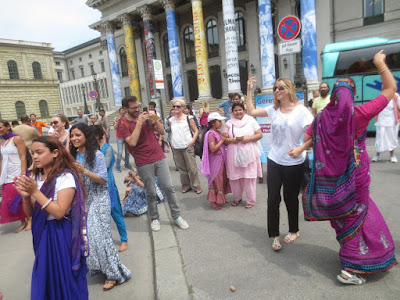
Then the husband took a picture of his wife dancing with a devotee lady.
By contrast to Munich, the Prague Ratha-yatra is very short, about an hour and a half. It is in a busy tourist section, but the stage show was a bit off to the side.
Flying to New York City
After just proofreading and no harinama for a week, you can see I was happy to be dancing in the kirtana again.
Some continue dancing after our procession ends.
I wrote Japa Transformations, things were improving.
When I moved to Stuyvesant Falls
my japa gradually came
under control. Starting at
midnight in the sanctity of
my bhajana kutiraI began
to report: 'I was not troubled
by outside thoughts.' The
remaining distraction is
that I think of what to
write in my Japa Report
while I’m chanting.”
ISKCON Toronto Vyasa Puja Book – Submit Your Offering!
→ The Toronto Hare Krishna Temple!
Hare Krishna,
Please accept our humble obeisances. All glories to Srila Prabhupada.
The appearance day of Srila Prabhupada is a very special occasion for all ISKCON devotees. Srila Prabhupada appeared on Nandotsava – the day that Nanda Maharaja had a big festival to celebrate the birth of Lord Krsna (Sri Krsna Janmastami). This year, Srila Prabhupada’s Vyasa Puja falls on Sunday, September 6th, 2015 and celebrations will be from 11am-3pm at ISKCON Toronto and will continue through to the Sunday Feast (6pm to 9pm).
This day is known as Vyasa Puja because the spiritual master is a representative of Srila Vyasadeva who is the author of the Srimad Bhagavatam. Vyasa Puja offerings are made by devotees who write and present personal messages to the spiritual master. The Governing Body Commission (GBC) for ISKCON has stated that every devotee in ISKCON should write an offering to Srila Prabhupada on Vyasa Puja.
We would like to encourage all devotees in our community to write a personal letter, in the form of an offering to Srila Prabhupada for this year’s festival and, to further facilitate this process, we will be making a special ISKCON Toronto Vyasa Puja Book for 2015. This book will be presented to Srila Prabhupada on the day of Vyasa Puja. Following the program, the book will be on display for devotees to read all the offerings by devotees of our community. Please note – doe to time constraints during the festival, we will not be able to have everyone read out their offerings during the main festivities. However, devotees are welcome to privately do so before or after the festival.
In order to facilitate this whole process, pre-printed pages have been prepared and we are asking devotees to hand write offerings onto these specially-designed pages. The maximum length of the offering is one page per person. If you wish to type your offering, you can use our Vyasa Puja online form at: http://tinyurl.com/SPOfferings2015 (form is also embedded below) - typed offerings must be emailed by 8:00am on September 6th. We will print out these offerings for you.
The hand-written offerings can be submitted in person at the temple, in the designated drop box, up until 11:00am on September 6th. Hand written offerings are encouraged.
We humbly encourage you to please take this opportunity to honour Srila Prabhupada with a personal offering! Hare Krsna!
Your Servants,
The Toronto Hare Krishna Temple
Guidelines for Your Written Offering:
- Write your offering in the mood of a personal letter to Srila Prabhupada. Write in a style as if you are addressing Srila Prabhupada directly (e.g. “Srila Prabhupada, it is by your mercy that I have come to Krsna consciousness.”)
- The Vyasa Puja offering is meant for glorifying the spiritual master. So offerings need to be made in that mood and not be used as a platform for airing one's grievances.
- You may wish to read the previous year’s Vyasa Puja offerings made to Srila Prabhupada by various senior devotees around ISKCON. It may give you some ideas of how to express yourself. These can be found here: http://prabhupada.krishna.com/homages
- It is a courtesy to start your offering with Srila Prabhupada’s pranama mantras; we have already printed these onto the official pages. A suggested opening is as follows: “Dear Srila Prabhupada, Please accept my humble obeisances. All glories to you on this auspicious occasion of your Vyasa Puja.”
- The main content of the offering should glorify the role that Srila Prabhupada is playing in your life as well as express your indebtedness to him. You may also include reports about your spiritual growth, how you are meeting challenges and how you are carrying out his orders.
- To end the offering it would be nice to show one’s appreciation and desire to please, by some nice phrase such as “Your Humble Servant” or something similar.
- If you have any questions, concerns or challenges, feel free to write to us at SPofferings@torontokrishna.com
- Please note, the temple reserves the right to not publish an offering if it is deemed inappropriate.
Submission Requirements and Deadlines
- Hand-written offerings must be submitted no later than 11:00am at ISKCON Toronto on Sunday, September 6, 2015
- Typed offerings must be submitted via http://tinyurl.com/SPOfferings2015 (form is also embedded below) no later than 8:00am on Sunday, September 6, 2015
Jhulan Yatra
→ Ramai Swami
Devotees serve the Lord during the summer by placing Him on a boat, taking Him out on procession, applying sandalwood on His body, fanning Him with a camara, decorating Him with jeweled necklaces, offering Him palatable foodstuffs, and bringing Him out to swing in the pleasant moonlight.
Jhulan Yatra is one of the most popular celebrations in ISKCON temples around the world. Thousands of years ago the divine couple, Radha and Krsna, along with Their cowherd friends, took part in joyful swinging in the pleasure groves of Vrndavan.
Lord Balaram Appearance day — Saturday, 29th,2015 –Special discourse on "The Glories & Pastimes of Lord Balarama" by His Grace Vaishnava Dasa
→ ISKCON Brampton
About Lord Balarama(Fasting till noon)
"If one has no connection with Balarama,even though one is very learned scholar or has taken birth in a very respectable family,these assets will no help him."
[Srila Prabhupada]
Of the three names repeated in the Maha[Great] mantra 'Hare,Krsna and Rama, Rama refers to lord Balarama.So the maha mantra repeated and chanted over two thousand times daily by ISKCON devotees illustrates how important He is in Guadiya tradition.
He is the Original Guru.So the guidance of lord Balarama is not only helpful but essential to reach Krsna.
Following a spiritual life style requires strength to hold off the advances of a world intent on selling you products and life choices you don't need.Strength to aspire the goals of spirit,outside this body of blood n flesh,that we inhabit.Strength to aim for a spiritual destination despite the seeming pleasures of this world.
Lord Balarama is central to Srila Prabhupada's advice on making spiritual advancement,as he outlines in Srimad Bhagavatam:" Jnanasim' the sword of knowledge,is given by Krsna,and one who serves the Guru and Krsna in order to hold the sword of Krsna's instructions ,Balarama gives one strength.Thus one should accept the sword of knowledge from Krsna and be strong with the mercy of Balarama.We are therefore worshipping Krsna Balarama in Vrndavana."
But don't worry you need not to travel as far as India.If the pressures of this material world are feeling heavy on your shoulders these days,come to ISKCON Brampton to worship and glorify the most glorious Lord Sri Balarama and experience eternal joy and bliss.
11:15am - Guru Vandana
11:30am - Aarti
11:55am - Sri Nrsingadev Pranama
12:00pm - Lord Balaram Abhishekam(Everyone is welcome provided he/she is in vedic attire)
12:30pm - Glories of Lord Balaram
1:00pm - Aarti
1.30pm - Sanctified Free Vegetarian Feast
"If anything is donated to a devotee of lord Visnu in the name of lord Visnu,the charity is said to be pure and the only solution for liberation."
[Hari Bhakti Vilasa,11.64,Skanda Purana]
Sri Balaram Grand Feast....$251
Sri Balaram Maha Arati......$108
Mahabhiseka Ceremony....$201
Exquisite sringara...............$351
Please contact front desk/Amogha Lila Das alokearora@hotmail.com
Volunteering For Festivals:
For service opportunity,please contact Radha Gopinath Dasa.
 Maha Clean-up in preparation for Janamastami
Maha Clean-up in preparation for JanamastamiOn Aug 30th,2015,after the program
We humbly request everyone to stay behind for the pre-Janamastami festivities and help with the cleaning of the temple.
COMING UP AHEAD
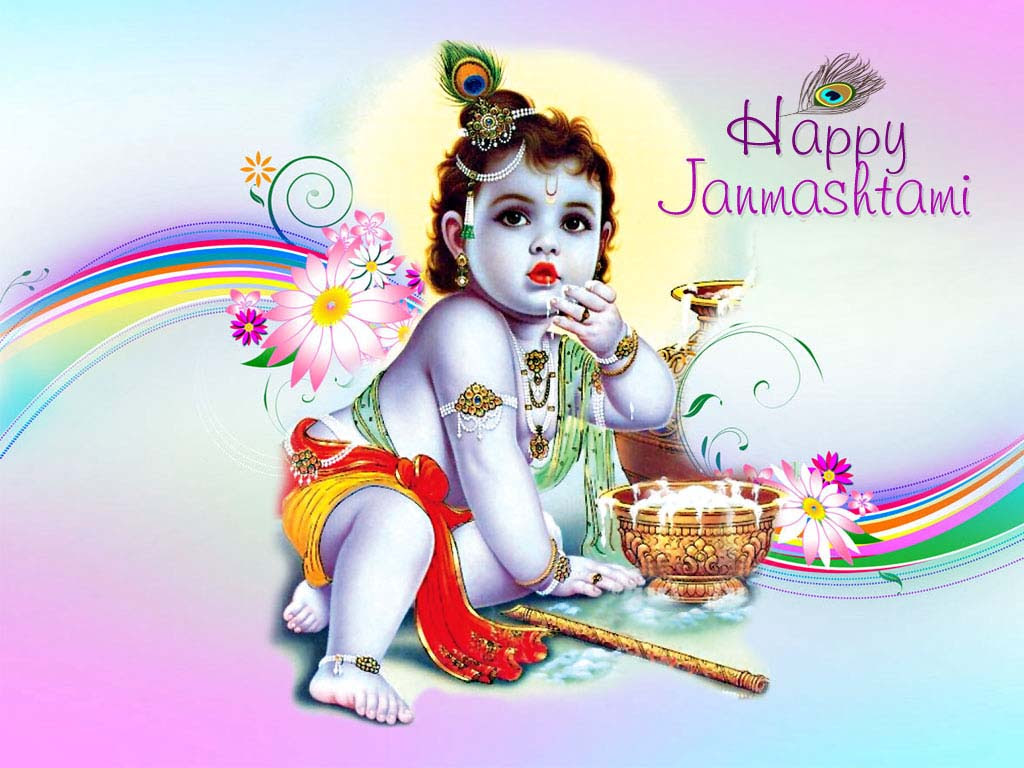 Sri Krsna Janamashtami(Fasting till midnight)
Sri Krsna Janamashtami(Fasting till midnight)Celebration on Sat Sep 5th,2015 all day!!
(Mangala arati program @ 5.00am)
 Sponsor a Kalash
Sponsor a KalashIf you and your family would like to participate in the bathing ceremony(Mahabhiseka Ceremony) of lord Krishna,please don't forget to sign-up for a kalash-$108/family.
**We've limited no of Kalash**
 Offerings for Sri Krsna
Offerings for Sri KrsnaYou are invited to bring vegetarian offerings (no onion, garlic, eggs, vinegar) of food for Krishna.[In brand new aluminium one or two serving sized container]
*Nothing store-bought. Must be fresh and homemade.
*No tasting or sampling. Krishna must be the first to taste your offering.
**Details of the program will be posted shortly**
 Appearance of Srila Prabhupada(Fasting till noon)
Appearance of Srila Prabhupada(Fasting till noon)celebration on Sep 6th,2015 (During Sun Love Feast)
**Details will be posted shortly**
The Glass Heart
→ Seed of Devotion
Thursday, August 20th, 2015
→ The Walking Monk
May the Source be with you!
Wednesday, August 19th, 2015
→ The Walking Monk
Prabhupada’s Palace in New Vrindaban Confirmed as Smriti Samadhi
→ New Vrindaban Brijabasi Spirit
By Madhava Smullen
As ISKCON’s 50th anniversary quickly approaches in 2016, and New Vrindaban’s 50th in 2018, long time members and residents are working to make sure that accurate histories of the past half century are available for future generations.
Since the 1980s, some devotees in New Vrindaban have mistakenly claimed that Prabhupada’s Palace is a Pushpa Samadhi. According to the Vaishnava tradition, a pushpa samadhi houses flowers worn by a departed Vaishnava, like Srila Prabhupada’s in Mayapur.
However although various stories have persisted over time that a flower or flower garland worn by Srila Prabhupada was installed at his Palace in New Vrindaban, they have since been confirmed as untrue through direct testimony by the devotees cited in the narratives.
In July 2015, after extensive research by board member Chaitanya Mangala including the testimonies, the ISKCON New Vrindaban board formally acknowledged that there are no flowers worn by Srila Prabhupada – nor one of his teeth, another claim — installed at his Palace.
Earlier inquiries by New Vrindaban GBCs Tamohara Das and Malati Devi also came to the same conclusions.
This does not, however, diminish the importance and glory of Prabhupada’s Palace. It has been appropriately identified as a smriti samadhi – a memorial shrine that preserves a Vaishnava’s memory by keeping worshipable personal items.
Three very special personal items of Srila Prabhupada’s are displayed in a glass case in his temple room at the Palace: the bongo drum that he played during the first Tompkins Square Park Harinama Sankirtan parties in 1966; a bronzed pair of his shoes; and original clay imprints of his feet.
In 1976 devotees traveled from New Vrindaban to the West 55th Street temple in Manhattan specifically to get these imprints from Srila Prabhupada in person. They are one of only two such imprints, which were copied and are now on display in ISKCON temples all over the world. But the original remains on display at Prabhupada’s Palace.
As a result of the efforts by the New Vrindaban GBCs, the Palace has been officially recognized by ISKCON’s Governing Body Commission as a Shrine and Memorial and included in the ISKCON Law Book as such.
In a 2006 resolution, the GBC also listed several other reasons as to why the Palace is to be held in high regard as a Smriti Samadhi by ISKCON members all over the world.
Firstly, Srila Prabhupada personally named New Vrindaban, spent quality time there, left behind a legacy of instructions for the project, and emphasized it by stating that it was non-different from Vrindavana, India.
Secondly, Prabhupada’s Palace at New Vrindaban is the only monument in the Western hemisphere built specifically and only to glorify Prabhupada. What’s more it’s built by volunteers who put years of their life into it as devotional service – a labor of love. And Srila Prabhupada reciprocated with that love, calling the devotees working on the Palace “my jewels.”
Finally, Prabhupada repeatedly inquired when his Palace would be finished and expressed his eagerness to live there. “When my palace will be ready I shall go there and stay,” he wrote in 1974. “I like very much that place.” And during a 1974 onsite visit, he said, “If you want, I am already living here.”
While Srila Prabhupada left this world before the Palace was completed, he is living there in spirit — his murti was installed at its grand opening ceremony in 1979, and he has been steadily worshiped there ever since.
And while his physical presence (vapu) may have been limited to four visits, he lives through his teachings (vani), which he lovingly imprints on the hearts of his faithful devotees.
Thus Srila Prabhupada is eternally present at his Palace in New Vrindaban. And to this day, it remains a place where he is the sole focus: from the monthly Sangams, to the mangala-aratis just for him, to the 30,000 tourists and pilgrims who visit every year and learn about his legacy, to the sweet memories that are shared about him by his disciples on his appearance and disappearance days.
And with a major restoration plan now underway, Prabhupada’s Palace is set to become even more renowned amongst future generations as his Smriti Samadhi – the greatest memorial to our Founder-Acarya in the Western World.
‘Like A River’ by Jahnavi Harrison – Music Video
→ ISKCON News

Like a River is the title track from the debut album of Jahnavi Harrison, 'Like a River to the Sea', released on July 24th 2015.
The track features a refrain from the Govinda Damodara Stotram by medieval saint-poet, Srila Bilvamangala Thakur and is a meditation on protecting sacred environments internally and externally.
Written, composed and arranged by Jahnavi Harrison and Gauravani Buchwald.
A Plainly-Named Book
→ The Vaishnava Voice
For the past twenty years, at least, people have been asking me my understanding of the various philosophical aspects and issues related to the subject of the guru and disciple relationship. Although many liked the traditional idea of practising spiritual life with a guide and teacher, they found some of the aspects inaccessible and some quite controversial. I always tried my best to convey to them both the tradition and the contemporary application as I understood it. When it became clear that successive waves of people were asking similar questions, and that some of them found my answers interesting and helpful, I started writing it down for them instead of speaking. Some of that writing has already been published as posts in my blog. Eventually I thought to compile it all to have everything in one place. I didn’t think of writing a book. But, as these things go, a book was the result. So here is a plainly-named book, The Guru & Disciple Book, and it will be coming out on September 3rd.
It will be available on Amazon and from other outlets.
